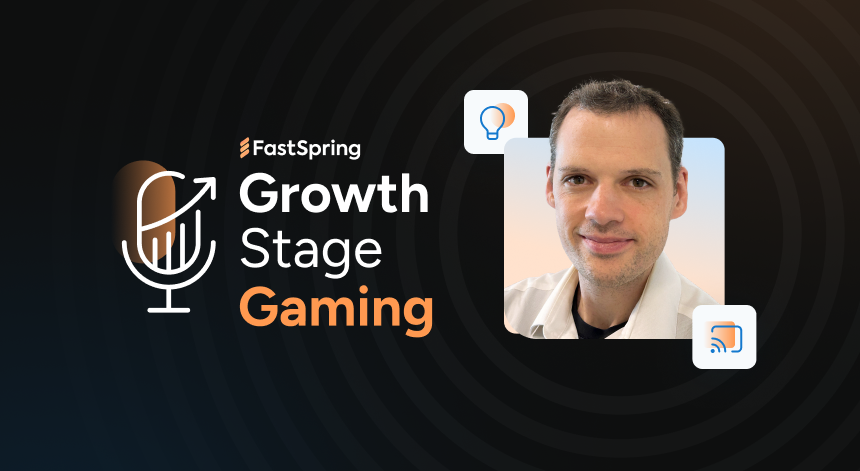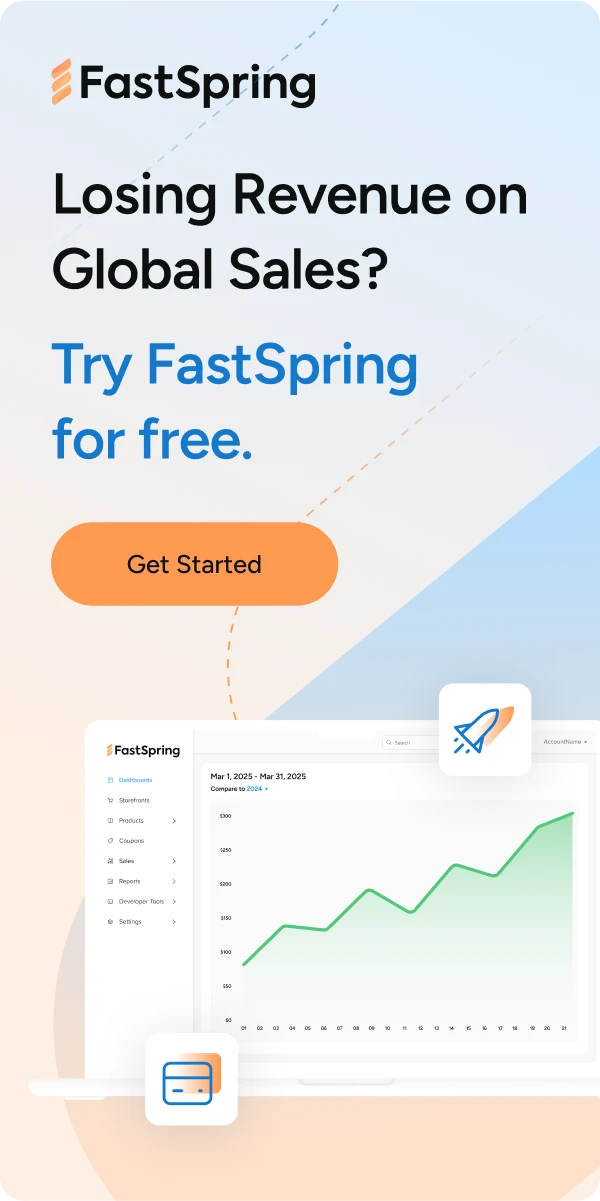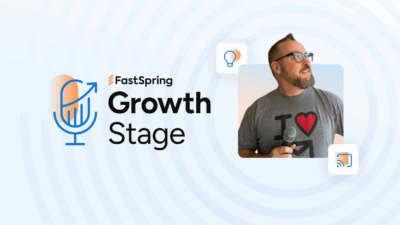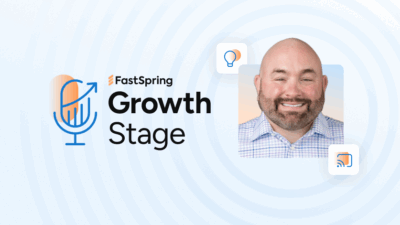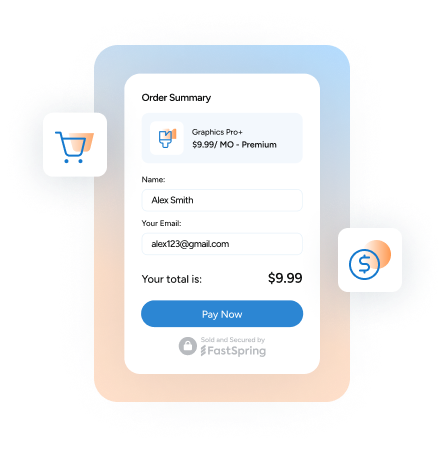If you’ve recently launched a web store to take advantage of new steering rules on iOS in the US or even if you’re an old pro at web store monetization, you may be wondering what is the best way to price and package my in-game items or subscriptions on my web store vs. what I offer in-game through app stores.
In this episode of Growth Stage we interview Chip Thurston, Head of Gaming at FastSpring and former monetization leader at Scopely and SciPlay, about his thoughts around how pricing and packaging strategies differ in-game vs. on a web store, what are the top considerations, the role of creators in driving web store value, and how to strike the right balance in rewarding players and increasing your profits.
If you’re scratching your head wondering what the best pricing and packaging strategies are for your game and web store, don’t miss this episode of Growth Stage. Watch or listen now!
Podcast Full Interview: Audio


Listen online or find it on more podcast services.
Podcast Full Interview: Video
Transcript
David Vogelpohl (00:04)
Hello everyone and welcome to Growth Stage by FastSpring where we explore how digital product companies can increase the value of their business. I’m your host David Vogelpohl supporting the digital product community as part of my role here at FastSpring and I love to bring the best of the community to you here on Growth Stage. In this episode, we’re going to be talking about pricing and packaging for gaming web shops and joining us for that conversation is someone that knows quite a bit about that.
like to welcome Chip Thurston. Chip, welcome to Growth Stage.
Chip Thurston (00:36)
Thanks for having me. Happy to be here.
David Vogelpohl (00:39)
Awesome. Well, glad to have you here. And I know this is a topic that a lot of folks are curious about, especially with the rise of direct-to-consumer and web stores following the recent Apple and Google rulings. So really interested in unpacking this one a little bit on the pricing and packaging front. And for those that are watching and listening, what we’re going to be talking about today are Chip’s thoughts around how pricing and packaging strategies differ between game and web store.
What are the top considerations when forming your pricing and packaging strategy, the role of creators in driving web store value, and how to strike the right balance in rewarding players while increasing your profitability? It’s pretty deep topics, but I think we can get through them here today. Really excited to learn more about this from your perspective, Chip. But before we get started, I wanted to ask you a question that’s similar to a question I ask other guests on the show.
But what was the first mobile game you remember spending money on?
Chip Thurston (01:44)
That’s actually a tough question for me to answer because I am notoriously frugal when it comes to purchasing on mobile games. And I realized the irony of that, given that I used to manage monetization strategy and offer strategy on mobile games. ⁓ I think it was Pokemon Go, but it was only after years of playing the game and only after my kid got into it. And that was really like pushing me to get this one like limited time ticket to this little…
event that we were doing. So yeah, I’m tough to monetize, I will say.
David Vogelpohl (02:18)
that’s interesting. I remember in the early days of mobile, I just went nuts on buying, but they were premium games, not really in game items, but I would easily spend seven, 10 bucks or whatever on a game.
Chip Thurston (02:29)
you know, that’s a great point. I do remember buying ⁓ Mega Man X on mobile as a premium time. You just drop a few dollars and get Mega Man X. It’s one of my favorite games. So when they put it on mobile, I had to get it.
David Vogelpohl (02:35)
Yeah.
Now I have all kinds of questions about Mega Man X, but that’s not why we’re here today. So we’ll pause that conversation for later. But I was wondering if you could tell me a little bit about FastBring, what you do there and what your background is in pricing and packaging games and in-game items for mobile games.
Chip Thurston (03:01)
Yeah, absolutely. And I would say let’s make sure we put in the calendar a separate podcast about Mega Man X. We can do a full deep dive on that one. Yeah, so FastBring is a direct-to-consumer payment platform. We facilitate the checkout on a global scale to enable publishers to sell globally. And so in the case of gaming, this often means web stores. And so it’s really enabling them to sell outside.
David Vogelpohl (03:07)
Yes, definitely.
Chip Thurston (03:27)
of the common platforms like Apple and Google and sell directly to their players. And for me personally, my experience is coming from the game development side. So I’ve joined FastSpring as the head of gaming to help our sellers market and monetize direct to consumer. And that means everything from understanding what’s going on with the latest regulations to understanding the FastSpring product, to making sure they have the scalability and the tools that they need to succeed.
⁓ And where I come from in game development is most recently leaving Scopely where I was for a few years. And before that, I worked at SciPlay for a few years. And over that time, ⁓ more than a decade in the industry, I wore a number of different hats. I oversaw LiveOps and monetization strategy. So basically responsible for day-to-day revenue of the game and event strategy. I was also a marketing lead.
for mobile games, and so overseeing our community engagement strategy, user acquisition strategy, managing the teams that would help facilitate all of that, and everything done with the configuration management of how are we actually setting these up in the game and getting them executed on a day-to-day standpoint. And what that culminated in at Scopely was the opportunity to take on the web store strategy.
for a mobile game and being responsible for its growth and its goals and what we expected from our web store and how we were going to make it succeed, ⁓ even knowing that there were these Intel-steering policies in place from platforms like Apple and Google. so taking a lot of time to iterate and understand that landscape and drive it to success was what then led me to join FastSpring and say, OK, I want to drive this conversation more broadly in the industry.
David Vogelpohl (05:12)
That’s a cool perspective. And it sounds like your scope at Scopely was quite broad. But do you feel like that gave you like a holistic picture of the player’s journey and experience and how that fed into pricing and packaging?
Chip Thurston (05:27)
Yeah, absolutely. Because ⁓ one question I got a lot throughout my career there was the common thread between the marketing lead role and the monetization lead role, because they’re under two different disciplines, right? There’s the marketing vertical and the product vertical, and those are typically pretty bifurcated. There’s not a lot of ⁓ overlap between those two. But for me, the common thread was player empathy. For me, it always started with
What is the player thinking? How will they perceive this? What are they doing when we reach them, whether it’s with a user acquisition ad or a starter pack offer in the game? At the end of the day, it’s rooted in the player. And so, yeah, guess, circling back to your question, it really did, I think, give me that holistic perspective where now I’m thinking of the player.
before they reach the game, when they install the game. When they first install the game, what do they see? Or if they’ve been playing the game for five years, what is their experience in the game? And how do we do that? And then what’s that player journey outside of the game as we drive them to something like a web store?
David Vogelpohl (06:29)
Yeah, that holistic view. I often, when I talk to folks, particularly in marketing context, I always say, what was the person doing right before they experienced what you’re building? And I feel like coming from that perspective allows you to build better messages, more compelling information and experiences. ⁓ so it’s interesting to hear your perspective there. Now, when I asked you about fast spring though, and what fast spring enables, said something interesting that I just wanted to kind of dig in a little bit.
You said that often means web stores with direct-to-consumer. What’s an alternative path to direct-to-consumer than a web store?
Chip Thurston (07:09)
interesting. Well, this is something that’s really emerged this year, which is the option to surpass the web store entirely and go directly to a checkout page. So this is something in line with recent regulations, which we can get more into later. But the short version is for Apple, or for iOS in the United States today, publishers have the option to steer players directly into a checkout page, meaning there’s no store needed. It’s the most frictionless path available.
We’ve actually recently launched a solution with Asprin called Steer Safe, which is a great visual example of how publishers can do this. But it’s an interesting option where, OK, maybe we don’t need to build out this entire web store and have our players go from game to store to checkout page. We can remove that intermediary and say, just go from the mobile game to a web-hosted checkout page and then go right back into the game. So pretty seamless experience.
David Vogelpohl (08:07)
Yeah, it seemed like that was a big eye-opening moment for folks as steering became available. It was like, well, wait a minute. Why do I even bother to go to the shopping experience in this other place when I can just present the option to buy the item or whatever in the game and then link directly to a place where someone can do a direct checkout? I think a lot of people hadn’t really thought about that paradigm prior to steering becoming available. And I think it was this like light bulb moment for a lot of folks. So thanks for picking that apart.
But let’s get back to the store for a minute here. ⁓ And we have this kind of divergence of experiences for the player a little bit. And of course, there’s a financial incentive for the publisher to drive the player to do the transaction on the store to make higher profits and have a more direct relationship with those players. So earlier when I was asking you about your experience with pricing and packaging, you rooted it in player empathy.
understanding what their experience is like, where they’re at in the journey of the game. But help me understand more about that process. What does it look like to set pricing and packaging strategy between a game and a web store based on your prior experience or even the experience you’re having these days?
Chip Thurston (09:24)
Yeah, I think the first thing I think of and really the umbrella for me that that would all sit under when it comes to pricing and packaging for a new web store initiative, say for a mobile game, is really game economy. It really boils down to that and managing the economy effectively because most commonly what we see is ⁓ the purchases made on the web store give more value to the player than the purchases made on the mobile store.
you need to be able as a game to accommodate that in the game’s economy. And what I found was the most ⁓ layman’s way of looking at this was basically looking at your source versus your sink and saying, source is what we’re giving out to our players, whether it’s they can play this game mode and win this currency in that mode and win these prizes. And this is what basically the output is from the game to the player, what we’re giving to the player. And that includes purchasing too.
What are we sourcing from the store? What are we giving to the players for the dollars that they’re spending versus the sink, which is where players are sinking that currency. What is the input that we’re getting from those players? And that’s constant balance that has to be regulated. And the best games out there have very flexible ⁓ sink options so that they can be more flexible on the sourcing side. And so when I think about a web store, it’s saying, OK.
we’re going to launch this web store and therefore we’re going to incentivize players to go there, which means we’re increasing our sourcing. And that could be through lower pricing, it could be through more value per store, it could be through other ways that we can talk more about. ⁓ But if we’re increasing our sourcing through having this direct-to-consumer program, we also need to increase our syncing. So how are we going to do that? What modes in our game are we going to tweak?
or what incentives are we going to put for our players inside the game to sink those currencies such that things continue to stay in regulation.
David Vogelpohl (11:28)
Are those, is that the totality of key differences when pricing and packaging between in-game and app stores? mean, what about profitability? You kind of alluded to more value. that like discounts for more in-game currency? Help me understand what the variables are that are going, do go through your mind when you think about pricing and packaging between stores and web stores and in-game.
Chip Thurston (11:55)
Yeah, more tactically, I would say I would look for what our players want. Again, going back to player empathy and say which method will be most compelling to them. So typically it would be maybe more per purchase is where I would start more gems per dollar. If gems are your currency, more hard currency per dollar when spent on the web store versus on the mobile store. So say I spend a $10 purchase on mobile and get a hundred gems.
Well, maybe if I go to the web store, that becomes a $10 purchase for 110 gems or 120 gems, whatever that right percentage could be, again, depending on your game’s economy and flexibility there. Or instead of more per dollar, it could be a discount. It could say, OK, that $10 purchase on mobile that gets me 100 gems is now $9 or $8 on the web store for the same 100 gems.
either discounting it or giving them more. And you could even A-B test or run some side by side to see which one is more compelling to your players. And it’s not just compelling to your players, but also which one is better for your game’s economy. Maybe you find that ⁓ the 120-gems or 110-gem option is a little difficult to accommodate from a game economy standpoint, so you opt for more of the discount route. There’s several different variables to evaluate as you try to run those. But beyond the core…
I think those are the base two options that most people jump to. But there’s more you could do, too. You could have exclusive items or exclusive bundles when you think about pricing for your web store as ways to incentivize players to go there. So you could put some cosmetics if your game has cosmetics, just visual items that have no impact or consequence or actual ⁓ utility in the game.
but you put those where players can only get them if they purchase on the web store. So you buy that $10 for 100 gems on mobile, or you can buy the $10 for 100 gems on the web store. But if you buy it on the web store, you get this little Hawaiian shirt that you can put on your avatar. And so players say, well, I might as well go purchase there because I get this cosmetic. Or it could be non-cosmetic. It could be a power item if you want to be even more aggressive and say, OK, this is a boost that you only get.
by purchasing on the web store. You could bundle it with other things. You could put it as a standalone item. And your players would understand if they really want to get that edge, that competitive benefit, they need to go purchase on the web store to get it through this exclusive item. And so there’s ⁓ all these different options. Basically, all the tools in the game economy and monetization toolbox are available. And it’s thinking about how you allocate those between the mobile game and the web store.
David Vogelpohl (14:44)
With player empathy though, like how do you balance that without like, you know, obviously players will often get agitated if there’s like play to win options in multiplayer and things like that. But how do you balance that with people that can’t or just don’t want to purchase outside the app store, just like live with it or like, how do you balance that with player empathy in mind?
Chip Thurston (15:09)
I think it’s just giving players choices, ⁓ empowering them to make the decision they want to make. so if a player, as long as you’re transparent with a player and they know that they have this option to get this other item elsewhere, and they’re choosing to purchase on the mobile store where you’re not forcing them to do that, you’re not putting them into the competitive disadvantage, they’re choosing to put themselves in that place in that case. ⁓ So I think it’s more just…
making sure that you’re communicating actively and not having someone say, I purchased this on mobile, not knowing that had I purchased it over there, I would have gotten more for it. It’s just ⁓ making sure that they’re aware and making the right choice that suits how they want.
David Vogelpohl (15:54)
Yeah, I see. So give them the choice and the opportunity to take advantage of it if it’s a good fit for them. ⁓ One of the interesting things that happens to me at every holiday and birthday for my kids is they come in with like a giant stack of like Visa gift cards and cash from relatives and things like that, but this really like sophisticated plan to use some of this money in their favorite games.
And then they asked me to help facilitate it. And many times the answer is I need to do the transaction through their web store because in app doesn’t support this, that, or the other and how they might’ve gotten that money from a relative. And so it makes me just think about like an additional benefit to a web store is taking advantage of payment methods, different card numbers and things like that that might not be able to be used.
through the app store for whatever reason for an individual player. I’m just curious, are there other advantages for players or publishers for transacting in web stores other than just like more money or better value for the player?
Chip Thurston (17:01)
Yeah, yeah, absolutely. Well, first I want to reflect on your kids getting a giant stack of gift cards. I want to make sure to send my kid to your Christmases.
David Vogelpohl (17:11)
Maybe not giant giant, but enough to be complicated, yeah.
Chip Thurston (17:12)
⁓
Yeah, think the benefits are numerous. Everyone tends to reflect on the profit, right, which is very significant. You pay 30 % of your purchases on Apple and Google ⁓ to Apple and Google for the usage of their platform. And there is a lot of value in that. And so ⁓ that continues to be a critical part. I would certainly not suggest forgoing that entirely.
But when you drive through a web store, it might be closer to 5%. So you just get a lot more profit per dollar spent from your player for all the revenue you’re getting. And that is important. But there are benefits otherwise too. There’s the ⁓ control that you have over the pricing and the flexibility you have. These ⁓ platforms like Apple and Google have a lot of guardrails on what you can do, how you can operate within them, how frequently you can update things, or even
to some extent the price points you can offer your players. When you’re on a web store, there’s no guardrails for better or worse, right? You have as much control and as much flexibility as you want in how you’re communicating to your players and what you’re pricing things at, what your strategy is. And so we’ve seen publishers find some value in that and taking advantage of the freedom that they have on a web store, even a website versus what they have on the mobile platforms. And another big one is the data.
that’s available to them. ⁓ When we’ve seen in recent years that Apple has really cracked down on privacy and the amount of data that they’re sharing with publishers. And that’s been detrimental to user acquisition efforts and how laser targeted game publishers can be in acquiring valuable new players. Well, on a website, you’re getting that data. It’s not as protected. And so you have a lot more
information at your disposal that then you can use to target more players and grow your games. And so there’s this really nice flywheel where you’re getting more profit from it, you’re getting more margin, which then you can use to put into your UA and your UA is now better informed because you have this great data. And so it can be this really healthy growth cycle for games.
David Vogelpohl (19:27)
Assuming people are being compliant with their data on their website, of course. Yeah. What about for the player? Like what’s in it for them? Like the example I gave was like, well, I can use more payment methods more easily. ⁓ what, what else is in it for the player to transact other than money or value?
Chip Thurston (19:32)
Of of course.
Yeah, I ⁓ think it does boil down to one, the transact how you want with the methods at your disposal, whether it’s a credit card or Apple Pay or ⁓ gift cards or whatever you have and being able to do that. I think there’s a nice global scale to it where being able to reach maybe different regions and different things with those local currencies.
in a way that certain merchants will be able to provide. And so if I’m someone that might be in one of those more remote ⁓ places, maybe that’s more appealing to me and a bit more accessible than it would be otherwise. ⁓ But the main benefit for the player really is the incentive that the publisher is putting on there. It’s saying, I get more out of my purchases by purchasing on a web store. And so…
⁓ That’s really nice for me as a player because I have maybe those extra power items. So we’re just getting a little bit more hard currency than I would be getting otherwise that then I can use in the game and engage with.
David Vogelpohl (20:52)
I’m a publisher and I hear someone say, know, ⁓ well, direct to consumer is a way to have a more direct relationship with your players instead of always going through the intermediary of ⁓ app stores or marketplaces. ⁓ That makes sense, right? Like every business wants to have a direct relationship with their customers. What’s the player’s benefit from a direct relationship with the publishers and studios that make the games they love?
Chip Thurston (21:21)
Yeah, I think it’s having a more personalized experience. You can ⁓ get served offers that are more relevant to you and something that may be more appealing to you or maybe even more valuable. ⁓ The publisher can better grow those games and develop the games that you love. And so ultimately it should be good for the industry when games inherently become more profitable through direct to consumer, just becoming more more commonplace. That can mean more ⁓ development.
for the games that you have. And ultimately, think more creative concepts getting greenlit because the threshold for success is lowered a little bit because games are more profitable. And so I’m getting a bit beyond the direct relationship piece, but I think there’s so much more benefit to gaming as a whole that players writ large will benefit from ⁓ just by virtue of direct-to-consumer on this upward trajectory and
increasing the profitability of the entire industry.
David Vogelpohl (22:23)
Yeah, it feels like on a personal level, the strongest relationships I have with brands in my life, or when I have that direct relationship and my experience transcends the devices that I’m having that relationship or an experience on. And so for games, for me, it personally means things like Fortnite and Rocket League in that, in the Epic universe in particular, and having that connected experience through my Epic account and all these different
places. And then non-gaming, it’s things like Netflix, where I’m really transcending between devices. But my relationship is with Netflix, and that’s a very fluid experience as I flow through there. So these kind of things are on my mind when I think of player value ⁓ outside of the monetary piece of it. ⁓ So let me switch gears a little bit here. ⁓
Before steering, you talked about how with steering now we can just link to a checkout instead of like a whole store. But before that, outside the US, the only way to bring players there without additional fees is to market outside of your game. And I know ⁓ creators play a really big role there, but I’m just curious what you view the role of creators and influencers are.
with web stores and are they important or secondary or like how do think of their connection?
Chip Thurston (23:53)
Yeah, I want to underscore one point you made there, which is that steering is still somewhat limited in just geographically where it can be implemented and even by platform. mean, it’s really iOS in the United States is where I’ve seen the most readily available opportunity unlocked for steering.
And that’s what’s driven so much of the recent conversation in the industry. And even the presentations I’ve been giving and the talks I’ve been having have been really focused on steering because that is the hot topic of the day. But when I look at a global scale, there are still these anti-steering policies in place to say, we can’t directly steer players outside of the US to these stores. so the question there is, OK, well, then how do we grow the web store? What are the methods available to us?
And I think that that strategy still needs to be considered and really optimized as well. And circling back to your question, yes, that’s where creators can come in. I would start by saying we need to identify what are the growth vectors available for our web store? We know we can’t take players directly from the game into the web store steering. We know we cannot do that under certain regions outside the US. And so if we can’t do that,
David Vogelpohl (25:07)
Outside the US.
Chip Thurston (25:11)
What can we do? What are the ways we can get players into our web store? And this is the exercise I did when I was at Scupl.ly of really trying to understand how we could grow. And so depending on the game, that could mean content creators, it could mean social media channels, which again, since you’re not inside the game, you can talk more openly about your web store there, regardless of what country you’re in. It could mean an email.
program where you’re reaching your players directly via email. It could mean community like a subreddit or a Discord channel. There are all these different places that you can talk about it. And why I think content creators are such a critical channel, critical growth vector to identify there ⁓ is one, they’re great about developing a meaningful relationship with your players. Your players will trust them and understand what they’re saying. Two, you’re giving your…
content creators a pretty compelling reason to talk about it because they have a clear case to make to their players of whatever that incentive is that you’ve built into your web store. So they’re advocating for, hey, players, make sure you purchase on that web store because you get 10 % more there. the players are happy because they’re learning about this and they’re getting to go this other platform where they’re going to earn more.
And the content creators are happy because they’re giving value to their audience in that case and developing a more meaningful relationship there. So I think it is mutually beneficial. And I think at the end of the day, it becomes a really effective way to grow your web story. And the best part is that it’s rolling agnostic because the anti-steering policies are really specific to what you can say inside of your game and how you can route players inside of your game. But for content creators, there’s not really ⁓ a firm regulation of what you
they can and cannot say about the existence of a web store and the value of a web store. And so it’s something that can drive growth regardless of where these regulations go.
David Vogelpohl (27:09)
You know, this reminds me of a conversation that you and I had with Justin Sacks of Nexus, nexus.gg for those watching and listening, which operates a creator program platform for game companies. And one of the things I remember Justin talking about, he’s actually a guest on this show before too, ⁓ was how publishers are thinking about creator attribution.
Are creators actually driving players to spend more? ⁓ Are the creators getting credit for purchases that were going to happen anyways? And I thought one of the really interesting things Justin had pointed out about all that was that with web stores, you often can have a great degree of confidence that that was a unique purchase. And of course you get the additional profit from that, from going around the marketplace, if you will.
But it was a very strong attribution signal when players were using creator codes in the web store. I don’t know if you remember that conversation very much or have any thoughts, but in general, what do you think about the role of attribution web stories and creators?
Chip Thurston (28:19)
Yeah, I think it’s a very compelling business case because I think the concern there is cannibalization. It’s saying, if I’m going to pay a percentage of the revenue to these content creators for the purchases that they drive, well, who’s to say they wouldn’t have already made that purchase without me paying that percentage of revenue? And so that’s the number one concern I’ve heard when it comes to considering content creator strategy. And for anyone with that concern.
I would encourage you to go to Nexus because they have some really compelling data that illustrates that those purchases are incremental, that they are either someone who was purchasing, but now they’re purchasing more, more frequently or at a higher price point, or it’s taking someone who’s never purchased before and is now purchasing because of that advocacy. There’s the word I was looking for, because of that advocacy that’s coming from that content creator that they trust.
So yeah, I’m a firm believer in the value that they add. And frankly, that’s true beyond the scope of direct to consumer and web stores. It’s just the value of content creators overall and their ability to drive growth for a game.
David Vogelpohl (29:27)
Yeah, anecdotally, getting back to my kids here, because that’s the most important topic we’re talking about today is I definitely my 13 year old will come in and say, I saw this creator and they were talking about this and Roblox and we need some Robux to go achieve this strategy. So you can like see it directly, but there is that question. And I think the web store plays an interesting role there. ⁓ So, well, I wish we had time to like.
talk this out to the nth degree, but I’m just curious out of everything we talked about today, Chip, what is the one thing people should remember about their pricing and packaging strategy for their web store?
Chip Thurston (30:04)
⁓ everything, every word I said. ⁓ I think I touched on a lot of different tactics about how to grow a web store, whether it’s on the monetization side and how you incentivize your players, whether it’s on how to grow what channels, what growth vectors you identify and leverage to drive more traffic into your store. I think it can be
a bit overwhelming for someone who’s new to direct to consumer to say, all right, I want to build this web store, but man, I don’t know where to start. There’s all these different ways I should consider to grow it. How do I even incentivize that? How can my economy handle it? Where am I going to sink this extra currency? You can start asking all these questions. so the one thing I would say to take away from this conversation is to not let the perfect be the enemy of the good.
Don’t feel the need to get it perfect right out of the gate. I didn’t really touch on this earlier, but web shops don’t just launch and have 50 % of revenue of your game coming through the store. They grow over time. And so I shared a lot of strategies, but I would say pick one, try it, move forward, iterate on it. The important part here is just to get started and move forward.
David Vogelpohl (31:24)
Affection is the enemy of progress. And I think the number one thing I’m going to take from you today is the focus on player empathy. I think that was such a great place to root on. But I really love your idea of launch quick, iterate, and learn. Such an important piece. Well, this was awesome. Thank you so much for joining us today, Chip.
Chip Thurston (31:45)
Yeah, thanks, David. It was a pleasure.
David Vogelpohl (31:47)
If you’d like to learn more about what Chip is up to, you can find him on LinkedIn, Chip Thurston of FastSpring. And you can also visit fastspring.gg. Thanks everyone for joining us for Grow Stage. Again, I’ve been your host, David Vogelpohl. I support the digital product community here at FastSpring. And I love to bring the best of the community to you here on Grow Stage. Thanks everybody.




